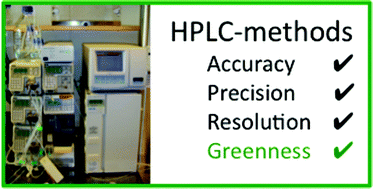HPLC-EAT (Environmental Assessment Tool): A tool for profiling safety, health and environmental impacts of liquid chromatography methods†
Abstract
A simple and efficient approach for profiling the greenness of

* Corresponding authors
a
Department of Biotechnology, Center for Chemistry and Chemical Engineering, Lund University, P.O. Box 124, Lund, Sweden
E-mail:
yasser.gaber@biotek.lu.se
Fax: +46-46-222 4713
Tel: +46-46-222 7363
b Department of Microbiology, Faculty of Pharmacy, Beni-Suef University, Beni-Suef, Egypt
c Current address: Technical University of Denmark, Department of Chemical and Biochemical Engineering, Soltoftsplads, Kgs, Lyngby, Denmark
d Infosys Technologies Limited, Mysore, India
e Microbial Biotechnology Center, Faculty of Pharmacy, Cairo University, Kasr El-Aini, Cairo, Egypt
A simple and efficient approach for profiling the greenness of

 Please wait while we load your content...
Something went wrong. Try again?
Please wait while we load your content...
Something went wrong. Try again?
Y. Gaber, U. Törnvall, M. A. Kumar, M. Ali Amin and R. Hatti-Kaul, Green Chem., 2011, 13, 2021 DOI: 10.1039/C0GC00667J
To request permission to reproduce material from this article, please go to the Copyright Clearance Center request page.
If you are an author contributing to an RSC publication, you do not need to request permission provided correct acknowledgement is given.
If you are the author of this article, you do not need to request permission to reproduce figures and diagrams provided correct acknowledgement is given. If you want to reproduce the whole article in a third-party publication (excluding your thesis/dissertation for which permission is not required) please go to the Copyright Clearance Center request page.
Read more about how to correctly acknowledge RSC content.
 Fetching data from CrossRef.
Fetching data from CrossRef.
This may take some time to load.
Loading related content
